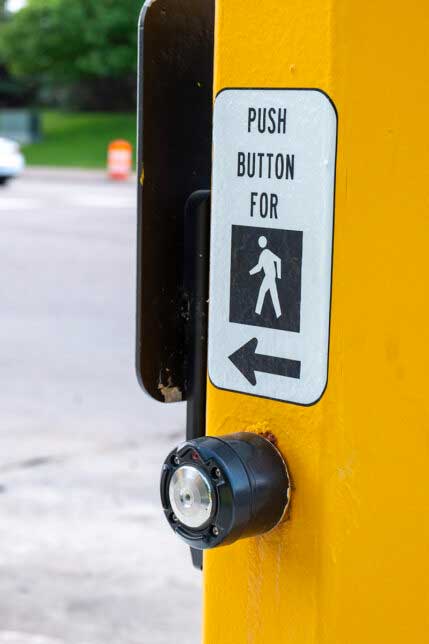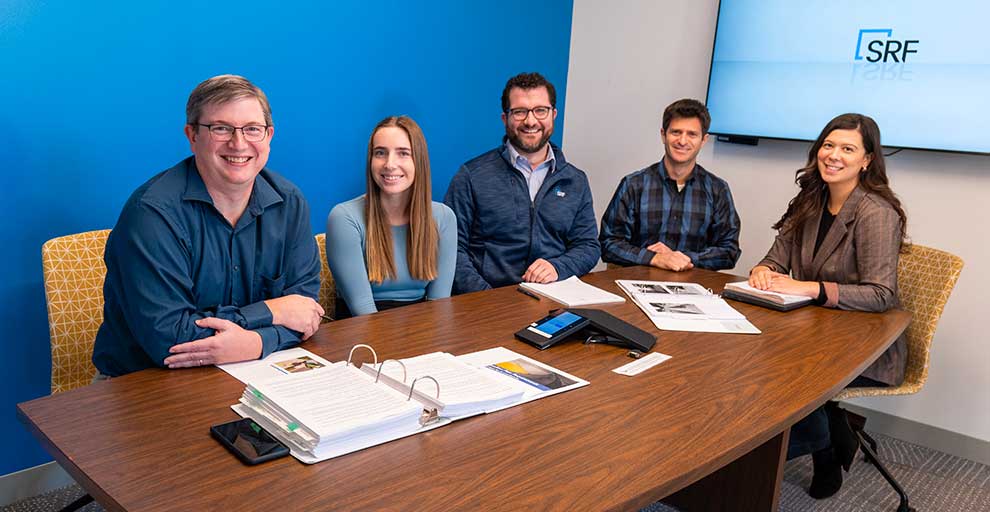ADA Compliant Curb Ramps
The American with Disabilities Act (ADA) was passed in 1990 to ensure that people with disabilities have the same rights and opportunities as everyone else. This led to a need for improvements and investments in public and private infrastructure. Upgrading ADA facilities continues to be an extensive and costly process as communities bring their public spaces and infrastructure up to the local, state, and national standards that have been developed in response to this important law.
Over the last 30 years, communities have been mostly incorporating the necessary ADA improvements as directed under federal law into their larger infrastructure projects, such as municipal utility projects or roadway reconstructions. However, some communities and agencies like Hennepin County, Minnesota, have been able to find other innovative and collaborative ways to make these improvements. SRF is currently working with the County to wrap up the first phase of a project focused specifically on ADA improvements. Accessibility Specialist Brady Rutman, PE, PLA, gives us an in-depth look inside this unique project.
Project Overview
The Hennepin County 2023 ADA and accessible pedestrian signal (APS) improvements project just reached a milestone with the installation of the final Phase 1 ADA compliant curb ramps this fall. SRF partnered with Hennepin County to deliver the 2023 improvements in line with the latest standards. SRF developed construction plans and specifications for four project phases and provided construction inspection and administration for the largest set of intersections (Phase 1). Phase 1 included 150 quadrants at 45 intersections on six different Hennepin County corridors, and all four phases combined include 225 quadrants at 65 intersections across 10 corridors.
Scope & Context
The core purpose of the County’s annual ADA projects is to provide ADA-compliant curb ramps on a set of County State-Aid Highways (CSAHs). Under federal law, projects with roadway alterations require compliant curb ramps to be provided at each impacted pedestrian crossing. In recent years, Hennepin County has met their obligation to upgrade curb ramps with separate ADA projects constructed ahead of bituminous mill and overlay projects on the same highways. The County goes beyond the federal requirement and expands the project scope to include APS improvements—audible and vibrotactile walk signals activated by touch—at all signalized intersections within the overlay extents.
SRF’s Role in the Project
The project has been an opportunity for multiple SRF groups to demonstrate technical proficiency. The design and construction of curb ramps requires consistent attention to detailed technical requirements because hasty planning and design can quickly lead to non-compliance or overspending.

- The design phase of the project began in the summer of 2022 with the evaluation of more than 400 curb ramp quadrants for ADA compliance. Accessibility Specialist Brady Rutman performed the field review, documenting existing slopes and sources of non-compliance of each ramp. Evaluation results were discussed with County staff, and those quadrants lacking ADA compliant curb ramps advanced to preliminary and final design.
- Detailed topographic survey data for design was collected through the combined efforts of SRF and Martinez Geospatial surveyors.
- SRF’s civil designers laid out preliminary ramp designs per MnDOT’s Curb Ramp Standard Plan, assessed right-of-way impacts, then developed construction plans, specifications, and engineer’s estimates for final curb ramp designs. Plans were developed in Bentley’s OpenRoads Designer.
- Led by Adrian Potter and Clayton Bayer, SRF performed traffic counts and submitted Signal Justification Reports for signalized intersections in the process of laying out the APS improvements.
- Project Manager Nathen Will kept the SRF design team on the County’s tight schedule, worked with the County to organize multiple bid packages, and received MnDOT State Aid approval for each submittal.
- The County organized the 10 corridors into separate bid packages, prioritizing the construction of Phase 1 plans to include most project intersections. Additional phases feature smaller individual corridors and select ramps that require easements to install.
- SRF’s construction group provided construction administration and inspection services for the installation of the Phase 1 curb ramps between May and September 2023. Project Engineer Dan Herzog and Lead Inspector Joe Keller teamed with Edna McKenzie and Midwest Select Contracting to oversee construction.
With corridors scattered across multiple Hennepin County cities, our design and construction teams were challenged to coordinate with numerous agencies and utility companies. In total, SRF gathered feedback and approval from 16 governing agencies including 11 cities, Ramsey County, Three Rivers Park Board, Minneapolis Park and Recreation Board, and MnDOT. Each project corridor had a separate set of impacted utilities, requiring coordination with a total of 26 utility owners.
ADA Guidance
Hennepin County’s project model (preceding mill and overlay projects with separate ADA projects on the same corridor) is similar to the City of Minneapolis’s approach, which is not typically followed by smaller cities and counties. Smaller agencies must meet the same federal requirements but often choose to include curb ramp improvements in smaller mill and overlay projects. The size of Hennepin County and cities like Minneapolis and their density of pedestrian facilities allows relatively efficient separation of ADA and overlay work. Each agency is challenged to upgrade curb ramps with limited funds, but funding is often available to finance these efforts.
The importance of accessible pedestrian facilities is being recognized across Minnesota. With the US Access Board’s recent release of the Final Rule on Public Right-of-Way Accessibility Guidelines (PROWAG), every agency in the country may soon be obligated to create more curb ramps at pedestrian crossings. Budgets are likely to be further stressed, and each agency will have incentive to meet ADA requirements efficiently.
Brady Rutman, PE, PLA, has been a designer in SRF’s Civil Engineering Group for more than 10 years and has been the ADA lead since 2016. As a Certified Accessibility Specialist and SRF’s ADA design expert, Brady relishes the role of reviewing plans and offering design guidance to SRF’s Civil and Landscape Architecture groups. Brady also manages SRF’s consultation with public agencies on ADA self-evaluations and transition plans. As a designer, he splits time between public transportation projects and private site-development projects.
Brady navigates the differences between state DOT’s ADA standards, Public Right-of-Way Guidelines, and the requirements for sites defined by state accessibility codes. He routinely provides internal presentations to SRF’s designers and project managers on the requirements and best practices relevant to a variety of project types. Brady has also presented national ADA requirements to local agency representatives within each MnDOT district and assisted the MnDOT ADA Team in updating the ADA Design Training.



